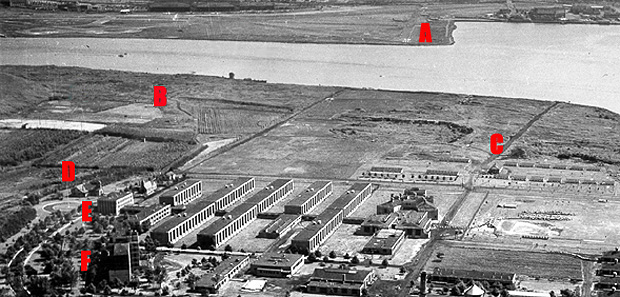
  A = Airport take-off area. B = Tree nursery, initial impact area. C = Poultry farm, halt point area. D = Protestant Mission House. E = Penitentiary. F = Rikers Island Hospital. |
The above 1948 aerial photo of Rikers Island helps in visualizing the 1957 airplane crash there: take-off from LaGuardia Airport (A), initial impact in the tree nursery (B), the halt point near the poultry farm (C), the Protestant Mission House turned into a first aid center (D), the Penitentiary whose officers and inmates participated in rescue efforts (E), and Rikers island Island Hospital where medical care was provided (F). The first three letters indicate approximate areas, not pin-point locations.
Time magazine of Feb. 11, 1957, carried a vivid account, partially excerpted here: . . . LaGuardia Field lay dreary and gray under a pelt of snow. In mid-afternoon 95 chattering, winter-clad passengers deposited themselves impatiently aboard Northeast Airlines' 2:45 p.m. flight to Miami . . . . The minutes on the ground stretched into hours, for LaGuardia was hemmed in by fog and snow to within three-quarters of a mile's visibility, and the unrelenting snow had piled up on the big wings of Northeast's DC-6A. Flight 823's Captain Alva Marsh, 48, a 19-year transport veteran, stood by waiting for clearance. Finally Pilot Marsh checked the weather again, decided to go. It was 6:01 p.m. when the plane lumbered down the runway into the darkness, lifted heavily off the ground and, slowly gaining altitude, went into an inexplicable left turn over the East River.
Screaming passengers — many of them with clothes blazing — jumped from the wreckage and staggered away. First to the rescue were 50 fast-moving trusties from the island's city-run penitentiary, who rushed outside, fought their way to the planeside and helped survivors to safety. The count: of the six crew members and 95 passengers aboard, 20 killed, 50-odd hospitalized. . . . . Various accounts of the accident give different numbers. For example, the Wikipedia version, states the passenger count as 95 and the crew count as 6, the dead as 20, and survivors as 81. The also gives other specifics: . . . The equipment used on this flight was a Douglas Aircraft Company DC-6A four-engined propeller airliner, registration N34954, first placed into service in 1955. . . . . At takeoff, with a nearly full complement of 95 passengers and 6 crew members (3 flight crew & 3 stewardesses), the plane weighed in at 98,575 pounds, just 265 pounds below maximum takeoff weight. Despite some sliding of the nosewheel on snow-covered pavement, the airplane was cleared to takeoff via runway 04 (040° magnetic heading), departing to the northeast of the field. . . . When it had reached a heading of 285° (nearly due west), it overflew Rikers Island. Its altitude was insufficient to clear the trees on the island, and the aircraft crashed, coming to rest within 1,500 feet of the point of first impact. The duration of the flight from takeoff to crash was approximately 60 seconds. The crash resulted in 20 fatalities & scores of injuries among the passengers, and no fatalities & several injuries among the crew.
. . . Full pax load, scheduled departure time 2:45 pm; late due to snow. ... pax-loaded aircraft towed to hanger for further de-icing. At 5:50 pm aircraft finally ready, T/O run at 6:02 pm on LGA Rwy 4; dark, WX cloudy, snow. Radar observed T/O roll, airborne 52 seconds; climbed , then 75' at .5 to .75 miles aircraft veered left; crashed on Rikers Island. On or about20 pax died from smoke inhalation, crew survived (but 2 F/As suffered burns). At crash site F/As told of explosion in tail of plane and smell of acrid oily smoke . . . CAB Panel of Inquiry met on 2Apr57: examined loading ... examined snow weight on aircraft, and deicing attempts (tail deiced?); ... examined if start malfunctions had drained batteries Feb 1st WX: FT= ZR, F, S-, and S. At T/O Ceiling = 800' vis 3/4 miles wind 12kts, S-; planes had been using LGA all day. . . . Capt Alva Marsh (49 yrs) testimony . . . had flown same a/c up from Fla that same morning; at T/O LGA wings seemed clean; roll, rotate, LG up, normal climb, Flaps Up at 300' and 140 kts; instruments showed no turn, no stall; Capt saw ground, pulled up, impacted, unbelted, saw fire; Capt could not suggest any cause for the accident. F/E stated NO power failure, engines good during T/O. . . .
De-icing Heater in tail |
To List of DOC staffers honored for air crash response.
To: List of names of those aboard Northeast Airlines DC-6A Feb. 1, 1957
To The Andersons of Canada remember.
To Remembering Mario DeRosa.
To Remembering Esther Chopelas.
To CAB report on its investigation of the crash.
To: Other views, other voices: Rikers air crash
To: 1989 airplane crash into Rikers Island channel waters
To: NYCHS home page.
To
NYC DOC history menu page.